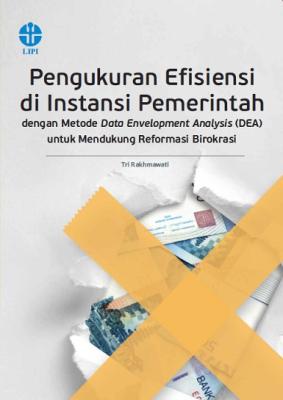Pengukuran Efisiensi di lnstansi Pemerintah dengan Metode Data Envelopment Analysis DEA untuk Mendukung Reformasi Birokrasi
Keywords:
Pengukuran Efisiensi, Instansi Pemerintah, Data Envelopment AnalysisSynopsis
Krisis moneter yang menyebabkan melambungnya harga kebutuhan pokok disertai maraknya praktik KKN di lingkungan pemerintahan membuat banyak pihak mempertanyakan kualitas kinerja instansi pemerintah. Hal ini menjadi fokus pembenahan yang dilakukan Presiden Jokowi, melalui Revolusi Mental dan Reformasi Birokrasi. Program-program pembenahan tersebut diutamakan pada peningkatan efisiensi dan pemangkasan pemborosan. Oleh karena itu, sebuah metode pengukuran efisiensi instansi pemerintah menjadi ha! yang krusial. Buku ini akan membantu Anda para pelayan publik dalam mengukur sejauh apa instansi di tempat Anda sudah beroperasi dengan efisien. Metode data envelopment analysis (DEA) dapat membantu Anda menentukan unit kerja yang paling efisien, mendeteksi sumber pemborosan, meningkatkan efisiensi kerja suatu unit, dan banyak lagi. Pembaca akan mendapatkan informasi komprehensif dan panduan mendetail dalam melakukannya.
Downloads
References
Akazili, J., M., Adjuik, S., Chatio, E., Kanyomse, A., Hodgson, M., Aikins, dan J., Gyapong. 2008. “What are the technical and allocative ef- ciencies of public health centers in Ghana.” Ghana Medical Journal 42(4): 149–155.
Akbarian, D. 2013. “A Ranking Method of Extreme E cient DMUs Using Super-E ciency Model.” Journal of Applied Mathematics and Physics 1(1): 1–5.
Al-Shammari, M. 1999. “A multi-criteria Data Envelopment Analysis model for measuring the productive e ciency of hospitals.” International Journal of Operations & Production Management 19(9): 879–891.
Andersen, P., dan N. C. Petersen. 1993. “A Procedure for Ranking E cient Units in Data Envelopment Analysis.” Management Science 39(10): 1261–1264.
Avkiran, N.K. 2001. “Investigating technical and scale e ciencies of Austra- lian Universities through data envelopment analysis.” Socio-Economic Planning Sciences 35(1): 57–80.
Banker R. D., A. Charnes, dan W. W. Cooper. 1984. “Models for estimat- ing technical and scale ine ciencies in Data Envelopment Analysis.” Management Science 30(9): 1078–92.
Charnes, A., W. W. Cooper, dan E. Rhodes. 1978. “Measuring the e ciency of decision making units.” European Journal of Operational Research 2(6): 429–444.
Charnes, A., W. W. Cooper, L. Seiford, dan J. Stutz. 1982. “A Multiplica- tive Model for E ciency Analysis.” Socio-Economic Planning Sciences 16(5): 223–224.
____. 1983. “Invariant Multiplicative E ciency and Piecewise Cobb-Douglas Envelopments.” Operations Research Letters 2(3): 101–103.
Chen, C. T., dan M. H. Lin. 2006. “Using DEA to Evaluate R&D Per- formance in the Integrated Semiconductor Firms -- Case Study of Taiwan.” International Journal of e Computer, the Internet and Man- agement 14(3): 50–59.
Coelli, T. J., D. S. P. Rao, C. J. O’Donnell, dan G. E. Battese. 2005. An In- troduction to E ciency and Productivity Analysis, Second Edition. New York: Springer Science+Businee Media, Inc.
Cooper, W. W., L. M. Seiford, dan K. Tone. 2007. Data Envelopment Analysis: A Comprehensive Text with Models, Application, Referenc- es and DEA-Solver So ware (Second Edition). New York: Springer Science+Business Media, LLC.
Darrat, A. F., C. Topuz, dan T. Yousef. 2002. “Assessing Cost and Techni- cal E ciency of Banks in Kuwait.” Paper presented at the ERF’s 8th Annual Conference in Cairo, January.
Direktorat Jenderal Anggaran. 2009. “Anggaran Berbasis Kinerja (Bagian I).” Diakses pada 18 April 2016, pukul 14.58. http://www.anggaran. depkeu.go.id/web-print-list.asp?ContentId=628.
Dittenhofer, M. 2001. “Internal auditing e ectiveness: an expansion of present methods.” Managerial Auditing Journal 16(8): 443–450.
Eilat, H., B. Golany, dan A. Shtub. 2008. “R&D project evaluation: An inte- grated DEA and balanced scorecard approach.” Omega 36(5): 895–912.
Farrell, M. J. 1957. “ e measurement of productive e ciency.” Journal of the Royal Statistical Society Series A 120(3): 253–290.
Handari, R. P. W. 2012. “Pengukuran kinerja SMA Rintisan Sekolah Bertaraf Internasional (RSBI) dan non RSBI berbasis ISO 9001 menggunakan data envelopment analysis.” Skripsi. Jakarta: Universitas Indonesia.
Ho, L.-A. 2008. “What a ects organizational performance?: e linking of learning and knowledge management.” 2008. Industrial Management & Data Systems 208(9): 1234–1254.
Jyoti, Banwet, D. K., dan S. G. Deshmukh. 2008. “Evaluating performance of national R&D organizations using integrated DEA-AHP technique.” International Journal of Productivity and Performance Management 57(5): 370–388.
ISO. 2015. ISO 9001: 2015 Quality Management Systems - Requirements. Geneva: ISO.
Kementerian PANRB. 2010. Grand Design Reformasi Birokrasi 2010–2025. Jakarta: Kementerian PANRB.
____. 2013. “Status Quo, Tantangan Terbesar Reformasi Birokrasi.” Ke- menterian PANRB, 13 Mei. Diakses pada 19 Oktober 2016. http:// www.menpan.go.id/berita-terkini/1241-status-quo-tantangan-terbesar- reformasi-birokrasi.
____. 2014. Peraturan Menteri Pendayagunaan Aparatur Negara dan Refor- masi Birokrasi RI No. 52 Tahun 2014 tentang Pedoman Pembangunan Zona Integritas menuju Wilayah Bebas dari Korupsi dan Wilayah Bi- rokrasi Bersih dan Melayani di Lingkungan Instansi Pemerintah. Jakarta: Kementerian PANRB.
Lee, H., Y. Park, dan H. Choi. 2009. “Comparative evaluation of perfor- mance of national R&D programs with heterogeneous objectives: A DEA approach.” European Journal of Operational Research 196(3): 847–855.
Lee, S. K., G. Mogi, S. K. Lee, K. S. Hui, dan J. W. Kim. 2010. “Econo- metric analysis of the R&D performance in the national hydrogen energy technology development for measuring relative e ciency: e fuzzy AHP/DEA integrated model approach.” International Journal of Hydrogen Energy 35(6): 2236–2246.
Liu, J. S., L. Y. Y. Lu, W. M. Lu, dan B. J. Y. Lin. 2013. “Data envelopment analysis 1978–2010: A citation-based literature survey.” Omega 41(1): 3–15.
Manasakis, C., A. Apostolakis, dan G. Datseris. 2013. “Using data envel- opment analysis to measure hotel e ciency in Crete.” International Journal of Contemporary Hospitality Management 25(4): 510–535.
Markovits-Somogyi, R. 2011. “Ranking E cient and Ine cient Decision Making Units in Data Envelopment Analysis.” International Journal for Tra c and Transport Engineering 1(4): 245–256.
Minh, N. K., P. V. Khanh, dan P. A. Tuan. 2012. “A New Approach for Ranking E cient Units in Data Envelopment Analysis and Application to a Sample of Vietnamese Agricultural Bank Branches.” American Journal of Operations Research 2(1): 126–136.
Myers, B.L. 2003. “Information Systems Assessment: Development of A Comprehensive Framework and Contingency eory to Assess e E ectiveness of e Information System Function.” Disertasi, Uni- versity of North Texas.
Neely, A. 2005. “ e evolution of performance measurement research: Developments in the last decade and a research agenda for the next.” International Journal of Operations & Production Management 25(12): 1264–1277.
Neely, A., M. Gregory, dan K. Platts. 2005. “Performance measurement system design: A literature review and research agenda.” International Journal of Operations & Production Management 25(12):1228–1263.
Ozcan, Y. A. 2014. Health Care Benchmarking and Performance Evaluation: An Assessment using Data Envelopment Analysis (DEA) Second Edition. New York: Springer.
Paradi, J. C., dan H. Zhu. 2013. “A survey on bank branch efficiency and performance research with data envelopment analysis.” Omega 41:61–79.
Palmer, S., dan David J.T. 1999. “Economics notes: De nitions of e ciency.” BMJ 318: 1138.
Rakhmawati, T. 2015. “Pengukuran e siensi institusi penelitian dan pengem- bangan (litbang) pemerintah menggunakan integrasi metode Data Envel- opment Analysis (DEA) dengan Logic Model.” Tesis. Jakarta: Universitas Indonesia.
Ramanathan, R. 2003. An introduction to Data Envelopment Analysis: A tool for performance measurement. New Delhi: Sage Publication India Pvt Ltd.
Rao, A.S. 2007. “E ectiveness of performance management systems: an empirical study in Indian companies.” e International Journal of Human Resource Management 18(10):1812–1840. Diakses kapan? doi: 10.1080/09585190701570973. Didownload pada 13 Maret 2017 pukul 14.40.
Sara dis, V. 2002. “An Assessment of Comparative E ciency Measurement Techniques.” Occasional Paper 2. London: Europe Economics.
Sucana, I W.G. 2013. “Reformasi Birokrasi Dalam Pencegahan Korupsi.” Kementerian Dalam Negeri, 12 April. Diakses pada 19 Oktober 2016. http://www.kemendagri.go.id/article/2013/04/12/reformasi-birokrasi- dalam-pencegahan-korupsi.
anassoulis, E. 2003. Introduction to e eory and Application of Data Envelopment Analysis: A Foundation Text with Integrated So ware. New York: Springer Science+Business Media.
Widyastuti, M. 2012. “Birokrasi dalam Tantangan Perubahan di Era Re- formasi.” Jurnal Madani 1: 29–38.
Zhang, A., Y. Zhang, dan R. Zhao. 2003. “A study of the R&D e ciency and productivity of Chinese firms.” Journal of Comparative Economics 31: 444–464.

Downloads
Published
Series
Categories
License

This work is licensed under a Creative Commons Attribution-NonCommercial-ShareAlike 4.0 International License.






























